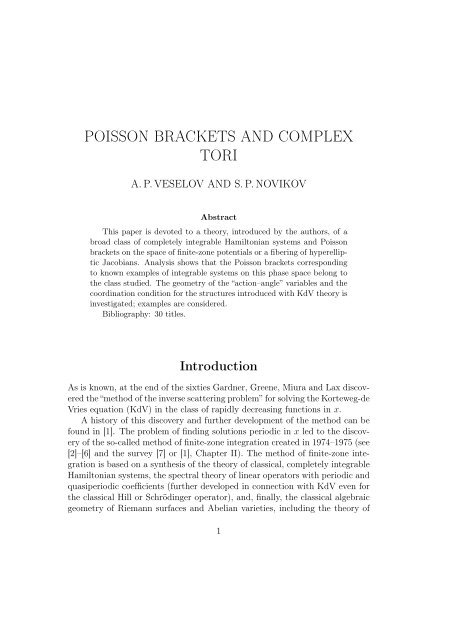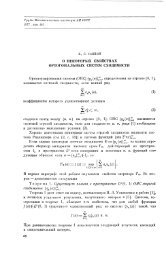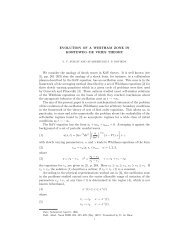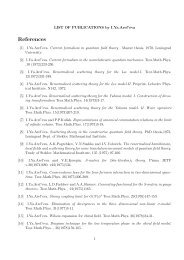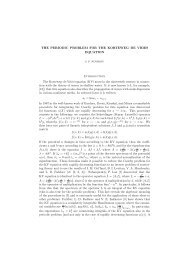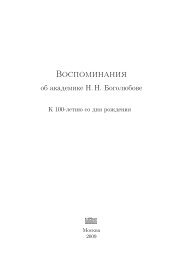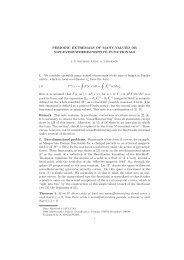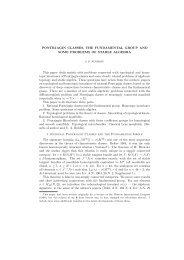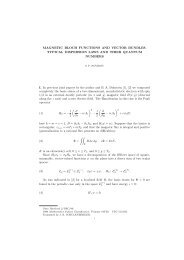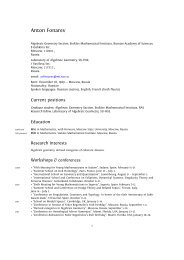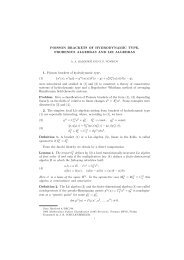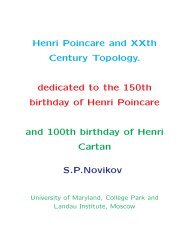POISSON BRACKETS AND COMPLEX TORI
POISSON BRACKETS AND COMPLEX TORI
POISSON BRACKETS AND COMPLEX TORI
Create successful ePaper yourself
Turn your PDF publications into a flip-book with our unique Google optimized e-Paper software.
<strong>POISSON</strong> <strong>BRACKETS</strong> <strong>AND</strong> <strong>COMPLEX</strong><strong>TORI</strong>A. P. VESELOV <strong>AND</strong> S. P. NOVIKOVAbstractThis paper is devoted to a theory, introduced by the authors, of abroad class of completely integrable Hamiltonian systems and Poissonbrackets on the space of finite-zone potentials or a fibering of hyperellipticJacobians. Analysis shows that the Poisson brackets correspondingto known examples of integrable systems on this phase space belong tothe class studied. The geometry of the “action–angle” variables and thecoordination condition for the structures introduced with KdV theory isinvestigated; examples are considered.Bibliography: 30 titles.IntroductionAs is known, at the end of the sixties Gardner, Greene, Miura and Lax discoveredthe “method of the inverse scattering problem” for solving the Korteweg-deVries equation (KdV) in the class of rapidly decreasing functions in x.A history of this discovery and further development of the method can befound in [1]. The problem of finding solutions periodic in x led to the discoveryof the so-called method of finite-zone integration created in 1974–1975 (see[2]–[6] and the survey [7] or [1], Chapter II). The method of finite-zone integrationis based on a synthesis of the theory of classical, completely integrableHamiltonian systems, the spectral theory of linear operators with periodic andquasiperiodic coefficients (further developed in connection with KdV even forthe classical Hill or Schrödinger operator), and, finally, the classical algebraicgeometry of Riemann surfaces and Abelian varieties, including the theory of1
<strong>POISSON</strong> <strong>BRACKETS</strong> <strong>AND</strong> <strong>COMPLEX</strong> <strong>TORI</strong> 9only if the derivatives ∇ τi Q in all directions tangent to the “general” manifoldof the constant annihilator M A provide a basis of the holomorphic 1-forms ofthe Riemann surface Γ.The proof follows immediately from the Propositions 1 and 2 by comparing(8) with the Abel transformation.2 The real structure. “Action-angle” variablesWe shall assume that the family of algebraic curves M n is given as a manifoldwith an antiholomorphic involution σ : M n → M n , σ 2 = 1, extended to an antiinvolutionof the fibering with fiber Γ: N n+1 → M n . The fixed manifold MAσthus consists only of curves Γ with an antiholomorphic involution σ Γ : Γ → Γ,σΓ 2 = 1. The form Q = Q(Γ, λ) dλ and the annihilator A here must also becoordinated in the natural way with the involutions σ and σ Γ of the fiberingM n+1 → M n with fiber Γ:a) σ ∗ ΓQ = Q on N n+1 ,b) σ ∗ A = A on M n .(11)The simplest class of real structures, which we shall call “elementary” forthe Hamiltonian systems of interest to us, can be described as follows. Weconsider M- or (M − 1)-curves Γ where the number of fixed ovals of the antiinvolutionσ τ is equal either to g + 1 (M-curves) or g ((M − 1)-curves). ForM-curves k = g or k = g + 1 is possible. For (M − 1)-curves only k = g ispossible (we assume that k ≧ g; see §1; the case k < g is also interesting, butwe do not consider it for the time being). The Hamiltonian H(Γ) must be real,i.e., H(σΓ) = H(Γ).Lemma. If the Poisson bracket (A, Q) is coordinated with the elementary realstructure, i.e., it possesses property (11), then the real collections γ 1 , . . . , γ kare invariant under the dynamics generated by H(Γ), where the γ i all lie onpairwise distinct, fixed ovals of the anti-involution:γ j ∈ a j , a i ∩ a j = Φ (i = i 1 , . . . , i g or i = 1, 2, . . . , g + 1). (12)For M-curves and k = g the possible collections γ i ∈ a i form the g + 1connected component which is isomorphic to real torus T g . For M-curves
10 A. P. VESELOV <strong>AND</strong> S. P. NOVIKOVand k = g + 1 or (M − 1)-curves and k = g there is only one connectedcomponent—the real torus T g+1 or T g .The lemma is proved by an obvious verification. We have the real structurewith the tori (12) in the case k = g for KdV and the case k = g + 1 for NS +(the nonlinear Schrödinger equation with attraction).Elementary real structures of more general type, by definition, represent atransformation S k σ Γ : S k Γ → S k Γ generated by the original anti-involutionσ Γ on the curve; the “real” subset (in the complex case the torus T k ) may bedistinguished among the fixed points S k σ Γ (x) = x in some manner distinctfrom (12).Nonelementary real structures for k = g arise in the important example ofthe very familiar sine-Gordon equation and for k = g + 1 for the NS − equation(the nonlinear Schrödinger equation with repulsion). For all systems admittinggeneral Lax matrix representations of order l + 1 we have k = g + l (see[7], Chapter III, and [16]); if the realness conditions are such that the socalledmonodromy matrix after a period (in the periodic problem) for thecorresponding linear Lax L-operator belongs to a compact Lie group (similarto the group SU(2) for the sine-Gordon and NS equations), then the realstructure is nonelementary.Suppose the Poisson bracket is given by a pair (A, Q) and there is given ananti-involutionσ : M n → M n , σ Γ : N n+1 → N n+1 ,while the Hamiltonian is real: H(σx) = H(x), x ∈ M n , X a Riemann surface.According to §1, we have the fibering (10)N (A,Q)J Q (Γ)−−−→ M Aover a “general” level surface of the annihilator A.Definition. A nonelementary real structure is an arbitrary anti-involutionτ: N (A,Q) → N (A,Q) commuting with the fibering (10), i.e., with the usualinvolution on the family of Riemann surfaces: σ, σ Γ . The realness conditionsfor A and Q remain the same (11). On fibers J Q (Γ) the transformation τ mustbe a superposition of translation and an isomorphism of the real commutativegroups J Q (Γ).
12 A. P. VESELOV <strong>AND</strong> S. P. NOVIKOVto Liouville, but also as integrals over the elements a j of the group H 1 (Γ\P, Z)where P is the set of poles of the form Q or the forms ∇ τj Q for its derivativesalong M A ; this proves the proposition.Lemma. Compact real tori T k are possible only whenk 2g + κ, (16)where κ is the number of essential residues of the poles of the form Q modulothe annihilator A.Proof. As indicated in §1, the number 2g + κ coincides for “general” bracketsgiven by the pair (A, Q) with the rank of the lattice D in the space C k of thevariables (8). Since the real anti-involution τ is an automorphism of the realgroup J Q (Γ) and the dimension of the torus over R is equal to k, inequality(16) means simply that the dimension of the torus cannot be greater than therank of the lattice. The lemma is proved.We shall call δ = 2k − 2g − κ (the corank of the lattice) the number ofvariables of “phase type”, if the real parts are compact tori.The varieties J Q (Γ) are fibered in the formJ Q (Γ) Cs /Z δ−−−→k−s ˜JQ(Γ), s δ,where ˜J Q (Γ) is a compact complex torus. Under the conditions of the lemmawe have s = δ.3 Poisson brackets coordinated with KdV theory.The most important examplesDefinition. A Poisson bracket on the phase space (4), where Γ are hyperellipticcurves of the form y 2 = ∏ 2gj=0 (λ − λ j) = R(λ) is said to be coordinated withKdV theory if all the higher KdV are Hamiltonian in this bracket. Here k = g.In [14] a number of examples were given of brackets coordinated with KdVtheory (see below). For such brackets J Q (Γ) = J(Γ) always, i.e., the usual Abeltransformation defined by means of the collection of basis holomorphic differentialforms linearizes the dynamics of virtue of Hamiltonians of the form H(Γ).
<strong>POISSON</strong> <strong>BRACKETS</strong> <strong>AND</strong> <strong>COMPLEX</strong> <strong>TORI</strong> 13Theorem 2. a) An analytic Poisson bracket is coordinated with KdV theoryif and only if all the forms ∇ τ Q—the derivatives in directions τtangent to a level surface of functions from the annihilator A—are holomorphicand generate the group H 1,0 (Γ).b) If the bracket is coordinated with KdV, then the coefficients of the expansion∞∑ ( z) kQ(Γ, λ) =qk (Γ), z = λ −1/2 ,2k=−Nare such that q 2l+3 (Γ) = h l (Γ) are Hamiltonians of the higher KdV withindex l 0, while the remaining coefficients q k belong to the annihilatorA.Remark 1. Part b) was established by the authors in [14].Proof. The usual Abel transformation linearizes the dynamics of all higherKdV; the necessity of the condition is therefore obvious. Suppose now thatthere is given a bracket (A, Q) such that ∇ τ Q = ω τ are holomorphic differentialsgenerating the entire space H 1,0 (Γ). Since z = λ −1/2 , from the holomorphicityof the derivatives ∇ τ Q along tangent directions to M A it follows thatthe expansion for large λ has the formQ(Γ, λ) =∞∑ ( z) 2k+3Hk (Γ) + Ann,2k=0where Ann is a series with coefficients in the annihilator. We shall prove thatH k (Γ) for k = 0, 1, . . . , g −1 are the Hamiltonians of precisely the first g higherKdV. We consider the standard set of holomorphic forms ω 1 , . . . , ω g normalizedby the conditions∮a jω s = 2πiδ js ,where a j , b j is the basis of cycles on Γ such thata i ◦ a j = b i ◦ b j = 0, a i ◦ b j = δ ij .We define two collections of variables ϕ i (i = 1, . . . , g) and ψ j (j = 0, . . . , g−1):ϕ s =g∑j=1∫ (γj ,ε j )P 0ω s , ψ s =g∑j=1∫ (γj ,ε j )P 0α s , α s = ∂Q∂H s∣ ∣∣∣A.
14 A. P. VESELOV <strong>AND</strong> S. P. NOVIKOVThe forms α s are holomorphic and have at λ = ∞ the expansion (z = λ −1/2 )[ ( z) 2sα s = 2 + O(z )]2g dz (s = 0, . . . , g −1 ).2The transition matrix ω s = A sj α j is formed from the coefficients of the expansionof the forms ω s , namely∞∑ω s = c sj z 2j dz,at the point λ = ∞, so thatj=0A sj = 2 1−2j c sj .For Abelian differentials of second kind Ω j with zero a-periods and having asingle pole at λ = ∞ with asymptotics Ω j = −d(z 2j−1 ) + O(1) the followingequality holds (see [19], §10–3):∮b sΩ j = c sj = 2 2j−1 A sj .From this it follows that the columns of the matrix A ij coincide with the vectorswhich on the Jacobians J(Γ) give the direction of the flows of the higher KdVwith the corresponding indices j = 0, 1, . . . , g − 1. On the other hand, thesecolumns, by definition, are the direction vectors of Hamiltonian flows withHamiltonians H 0 , . . . , H g−1 . Thus, for the first g flows coordination has beenproved. For the remaining flows it is automatically satisfied, since they can beexpressed in terms of the first g on our phase space.The proof of the theorem is complete.We now list the most important examples.Example 1. The standard bracket [20], [21]. From the results of [22] we derive{∫1 T}Q = 2ip(λ) dλ, A = T 1 , . . . , T g , ū = lim u dx ,T →∞ Twhere the T i are the periods of the quasiperiodic potential u(x), p(λ) is thequasimomentum, and dp(λ) is a differential of second kind with a single poleat λ = ∞,dp(λ) = d(z −1 ) + O(1),∮z = λ −1/2 ,a jdp(λ) = 0, j = 1, . . . g.0
16 A. P. VESELOV <strong>AND</strong> S. P. NOVIKOVExample 4. The Hamiltonian structure generated by the so-called latent isomorphismof Moser-Trubowitz (see [28]) and [13]) between the KdV dynamicson the space of finite-zone potentials and the classical Neumann systems describingthe dynamics on the sphere S g in R 2g+1 ,S g = { x: |x 2 | = 1, x ∈ R g+1} ,under the action of the quadratic potentialU(x) = 1 2g∑a i x 2 i .i=0The coefficients a i , representing the set of end points of the zones λ i , here playthe role of the annihilator. Using [28] and [13], we obtain (see also [27])Q = √ −R(λ)g∏(λ − λ 2j ) −1 dλ, A = {λ 0 , λ 2 , . . . , λ 2g } .j=0Example 5. The integrable case of Goryachev and Chaplygin in the dynamicsof a rigid body with a fixed point [30]. HereQ(Γ, λ) = arcsin 1 ( λ2µ 2 − 1 2 H − 2G ),λwhere H is the energy of the gyroscope, G is the Goryachev-Chaplygin integral,and µ is a parameter of the problem. The curve Γ is given by the equationy 2 = 4µ 2 λ 2 − (λ 3 − Hλ − 4G) 2 .Example 6. In the well-known Kovalevskaya case the action variables werenot computed previously. Let I 1 , I 2 and I 3 be, respectively, the energy, area,and Kovalevskaya integrals, and let γ i = s i be the Kovalevskaya variables (see[30]). Calculations lead to the resultQ(Γ, λ) = 1 [ √−λ2 √ −λ ln ( )(λ − I1 ) 2 − I32 ν 2−2 √ −λ (λ − 2I2 2) + √ ]−R(λ) ,R(λ) = ( λ ( ((λ − I 1 ) 2 + ν 2 − I3) 2 − 2ν 2 I2) 2 (λ − I1 ) 2 − I3) 2 ,while the curve Γ is given by the equation y 2 = R(λ). IntegratingQ = Q(Γ, λ) dλ over the “real” cycles a j on which the γ i lie, we obtain the
<strong>POISSON</strong> <strong>BRACKETS</strong> <strong>AND</strong> <strong>COMPLEX</strong> <strong>TORI</strong> 17action variables J j . In correspondence with the result of Kovalevskaya theAbel transformation linearizes the dynamics (we note that the replacement ofthe time and Hamiltonian structure proposed by G. V. Kolosov (see [29]) leadsfor this system to non-Abelian tori).The integrable Steklov case for a solid body in a fluid is also of majorinterest.Bibliography[1] S. P. Novikov (editor), Theory of solitons, “Nauka”, Moscow, 1980; Englishtransl., Plenum Press, New York, 1984.[2] S. P. Novikov, A periodic problem for the Korteweg-de Vries equation.I, Funktsional. Anal. i Prilozhen. 8 (1974), no. 3, 54–66; English transl.in Functional Anal. Appl. 8 (1974).[3] B. A. Dubrovin and S. P. Novikov, Periodic and conditionally periodicanalogs of the many-soliton solutions of the Korteweg-de Vries equation,Zh. Èksper. Teoret. Fiz. 67 (1974), 2131–2144; English transl. in SovietPhys. JETP 40 (1974).[4] A. R. Its and V. B. Matveev, Schrödinger operators with finite-zero spectrumand N-soliton solutions of the Korteweg-de Vries equation, Teoret.i Mat. Fiz. 23 (1975), 51–68; English transl. in Theoret. Math.Phys. 23 (1975).[5] Peter D. Lax, Periodic solutions of the KdV equation, Comm. Pure Appl.Math 28 (1975), 141–188.[6] H. P. McKean and P. van Moerbeke, The spectrum of Hill’s equation, Invent.Math. 30 (1975), 217–274.[7] V. A. Dubrovin, V. B. Matveev and S. P. Novikov, Nonlinear equations ofKorteweg-de Vries type, finite-zone linear operators, and Abelian varieties,Uspekhi Mat. Nauk 31 (1976), no. 1 (187), 55–136; English transl. inRussian Math. Surveys 31 (1976).[8] I. M. Krichever, Methods of algebraic geometry in the theory of nonlinearequations, Uspekhi Mat. Nauk. 32 (1977), no. 6 (198), 183–208; Englishtransl. in Russian Math. Surveys 32 (1977).
18 A. P. VESELOV <strong>AND</strong> S. P. NOVIKOV[9] B. A. Dubrovin, Theta functions and nonlinear equations, Uspekhi Mat.Nauk. 36 (1981), no. 2 (218), 11–80; English transl. in Russian Math.Surveys 36 (1981).[10] I. M. Krichever and S. P. Novikov, Holomorphic bundles over algebraiccurves and nonlinear equations, Uspekhi Mat. Nauk. 35 (1980), no. 6(216), 47–68; English transl. in Russian Math. Surveys 35 (1980).[11] V. G. Drinfel’d et al., Methods of algebraic geometry in contemporarymathematical physics, Soviet Sci. Rev. Sect C: Math. Phys. Rev., vol. 1,Hardwood Academic Publ., Chur, 1980, pp. 1–54.[12] B. A. Dubrovin and S. P. Novikov, A periodic problem for the KortewegdeVries and Sturm-Liouville equations. Their connection with algebraicgeometry, Dokl. Akad. Nauk SSSR 219 (1974), 531–534; English transl.in Soviet Math. Dokl. 15 (1974).[13] J. Moser, Various aspects of integrable Hamiltonian systems, DynamicalSystems (C.I.M.E. Summer School, Bressanone, 1978), Progress in Math.,vol. 8, Birkhäuser, 1980, pp. 233–289; also published in Dynamical Systems(Bressanone, 1978), Liguori, Naples, 1980, pp. 137–195.[14] A. P. Veselov and S. P. Novikov, On Poisson brackets compatible with algebraicgeometry and Korteweg-de Vries dynamics of the set of finite-zonepotential, Dokl. Akad. Nauk SSSR 266 (1982), 533–537; English transl.in Soviet Math. Dokl. 26 (1982).[15] V. I. Arnol’d, Mathematical methods in classical mechanics, “Nauka”,Moscow, 1974; English transl., Springer-Verlag, 1978.[16] I. M. Krichever, Commutative rings of ordinary linear differential operators,Funktsional. Anal. i Prilozhen. 12 (1978), no. 3, 20–31; Englishtransl. in Functional Anal. Appl. 12 (1978).[17] B. A. Dubrovin and S. M. Natanzon, Real two-zone solutions of the sine-Gordon equation, Funktsional. Anal. i Prilozhen. 16 (1982), no. 1, 27–43;English transl. in Functional Anal. Appl. 16 (1982).[18] B. A. Dubrovin and S. P. Novikov, Algebro-geometric Poisson brackets forreal finite-zone solutions of the sine-Gordon equation and the nonlinear
<strong>POISSON</strong> <strong>BRACKETS</strong> <strong>AND</strong> <strong>COMPLEX</strong> <strong>TORI</strong> 19Schrödinger equation, Dokl. Akad. Nauk SSSR 267 (1982), 1295–1300;English transl. in Soviet Math. Dokl. 26 (1982).[19] Georege Springer, Introduction to Riemann surfaces, Addison-Wesley,1957.[20] Clifford S. Gardner, Korteweg-de Vries equation and generalizations,IV, J. Mathematical Phys. 12 (1971), 1548–1551.[21] V. E. Zakharov and L. D. Faddeev, The Korteweg-de Vries equation is afully integrable Hamiltonian system, Funktsional. Anal. i Prilozhen. 5(1971), no. 4, 18–27; English transl. in Functional Anal. Appl. 5 (1971).[22] H. Flaschka and D. W. McLaughlan, Canonically conjugate variables forthe Korteweg-de Vries equation and the Toda lattice with periodic boundaryconditions, Progr. Theoret. Phys. 55 (1976), 438–456.[23] Franco Magri, A simple model of the integrable Hamiltonian equation,J. Mathematical Phys. 19 (1978), 1156–1162.[24] O. I. Bogoyavlenskĭı and S. P. Novikov, The connection between the Hamiltonianformalisms of stationary and nonstationary problems, Funktsional.Anal. i Prilozhen. 10 (1976), no. 1, 9–13; English transl. in FunctionalAnal. Appl. 10 (1976).[25] O. I. Bogoyavlenskiĭ, The integrals of higher stationary KdV equations andthe eigenvalues of the Hill operator, Funktsional. Anal. i Prilozhen. 10(1976), no. 2, 9–12; English transl. in Functional Anal. Appl. 10 (1976).[26] S. I. Al’ber [Alber], Investigation of equations of Korteweg-de Vries typeby the method of recurrence relations, J. London Math. Soc. (2) 19 (1979),467–480. (Russian; English summary).[27] , On stationary problems for equations of Korteweg-de Vries type,Comm. Pure Appl. Math. 34 (1981), 259–272.[28] 1 A. P. Veselov, Finite-zone potentials and integrable systems on the spherewith a quadratic potential, Funktsional. Anal. i Prilozhen. 14 (1980),no. 1, 48–50; English transl. in Functional Anal. Appl. 14 (1980).1 Editor’s note. There is no item [28] in the Russian original. The context suggests thatthe restoration given here is what was intended.
20 A. P. VESELOV <strong>AND</strong> S. P. NOVIKOV[29] Yu. A. Arkhangel’skiĭ, Analytic dynamics of rigid body, “Nauka”,Moscow, 1977. (Russian)[30] V. V. Kozlov, Methods of qualitative analysis in the dynamics of a rigidbody, Moscow. Gos. Univ., Moscow, 1980. (Russian)Translated by J. R. Schulenberger


